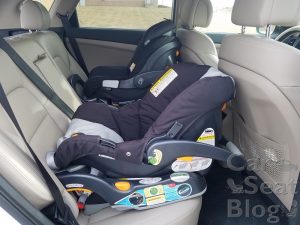Mythbusting: A Rear-Facing Car Seat Is Never Allowed to Touch the Front Seat

![]()
![]()
![]()
![]()
![]()
Can a Rear-Facing Car Seat Touch the Front Seat?


There aren’t a lot of absolutes in child passenger safety. Just when you think something is a hard and fast rule, like, never use lower anchors and seatbelts together, companies (I’m looking at you Clek and Nuna) decide that’s okay for one or more of their seats. Today we’re going to examine another “rule” that is commonly perceived as an absolute.
Myth: A Rear-Facing Car Seat Is Never Allowed to Make Contact With the Vehicle Seat in Front of It
I decided the first place to look was the CPS Technician training curriculum. As I read through the rear-facing module, all I found was this bullet point:
“Check the car seat instruction manual and the vehicles owners manual to determine if the car seat can contact the vehicle seat back in front of the car seat.”
There is nothing in the curriculum that says that a rear-facing car seat touching the front seat is inherently forbidden. This doesn’t mean that it can’t be forbidden, but it’s clearly not one of those hard and fast rules that we teach CPS Technicians in the certification course.
Now, let’s stop and look at why people think it’s forbidden. The first explanation I heard was that it prevents additional “ride down time” for the child and the child restraint. But is that a valid concern? Think about rear-facing seats with load legs that make contact with the vehicle floor. Also, think about rear-facing seats which allow what we commonly refer to as “European beltpath routing”. Euro belt routing means the shoulder belt portion of the seatbelt is routed behind the shell of the rear-facing seat, limiting its ability to rotate down in a frontal crash. All of these things essentially do what a rear-facing car seat making contact with a front vehicle seat does – limit the ability of the car seat to rotate down in a frontal crash. We know crash test data for seats with load legs are almost universally better than seats without load legs so this theory doesn’t hold water. Touching the vehicle seat back should not result in greater crash forces being experienced by the child. And theoretically, at least, it could actually provide a benefit.
 The second explanation I’ve heard is that it de-activates the front seat’s airbags. My research on this shows many articles without references, but I can’t find any official word on it that speaks for all cars. My very unscientific experiment showed that no matter how hard I pushed against the passenger vehicle seat, it did not cause the airbag to turn off with my husband sitting in the seat. Obviously, this isn’t hard or fast proof and shouldn’t be assumed to be as much.
The second explanation I’ve heard is that it de-activates the front seat’s airbags. My research on this shows many articles without references, but I can’t find any official word on it that speaks for all cars. My very unscientific experiment showed that no matter how hard I pushed against the passenger vehicle seat, it did not cause the airbag to turn off with my husband sitting in the seat. Obviously, this isn’t hard or fast proof and shouldn’t be assumed to be as much.
The third explanation I’ve heard is that it can change the angle of the rear-facing seat, causing it to be more upright than allowed by the manufacturer, or too upright for a very young baby. This argument actually has some merit but in order for this to occur, the vehicle seat in front has to be forcefully exerting pressure on the back of the car seat – pushing it into a more upright position. To be clear, this is not okay and should never be done.
But what about light touching, in a way that doesn’t alter the angle of the rear-facing car seat? Do any car seats explicitly ALLOW touching? The answer is yes.
Britax rear-facing only seats and convertible seats allow it if you move the vehicle seat back until it is JUST touching, after installing your rear-facing Britax car seat securely.

Chicco allows their rear-facing only seats (KeyFit, KeyFit 35 & Fit2) and convertible/all-in-one seats (NextFit, Fit4 & OneFit) to make light contact with the front seat after being properly installed, however, this is not stated anywhere in the manuals or on Chicco’s website. Therefore, we suggest you call Chicco yourself to confirm this information since we are unable to provide you with a direct link to this allowance.

Evenflo permits contact between front vehicle seats and its rear-facing convertible or all-in-one car seats. As per the FAQ section of their website – the car seat should not be wedged in and should be installed in accordance with both the car seat instructions and the vehicle owner’s manual.

Graco It is OK for the back of the car seat and/or the car seat headrest to touch the back of the front vehicle seat when installed rear-facing as long as it is allowed by the vehicle manufacturer and it meets the following criteria:

Do any car seats forbid touching explicitly?
The answer is also yes. The most significant of these is Evenflo, whose rear-facing only seats, Embrace, Nurture, LiteMax & SafeMax Infant, all require 1.5 inches of space between the child restraint and the vehicle seat when the car seat is installed in an outboard seating position. This information can be found under the subtitle “Location Warnings” (near the beginning of the instruction manual). This rule does not apply when these infant seats are installed in the rear center seating position of the vehicle. This 1.5″ space rule also does NOT apply to any Evenflo convertible or All-in-One seat.
Okay, so no clear consensus for car seat manufacturers. What about vehicles?

I looked at my vehicle’s manual (2015 Honda Odyssey). I read the airbag and child safety sections thoroughly and nowhere does it forbid a car seat from touching the front vehicle seat. It DOES say that if there’s no front seat passenger and the airbag light doesn’t switch to the OFF position, it could be because a car seat is touching the vehicle seat back, but it never says not to do this. So it looks like this pressure, at least in my car, will actually prevent the airbag from turning off, rather than resulting in it not deploying if it’s supposed to.
For good measure, I checked my husband’s as well, since they are different companies and both have advanced airbags. Unlike my Odyssey, my husband’s Nissan Rogue does seem to forbid it, though not in very certain terms. In a troubleshooting section, they said that if the airbag light is not working as expected, “make sure that a child restraint or other object is not pressing against the rear of the seatback.” I would assume this is as good as saying don’t do that, but then it also forces the question is touching the same as pushing?
This might be the heart of the issue. Is light touching of a car seat likely to change the airbag function? I would argue no. If you’re putting less than 2 pounds of pressure (which seems to be an allowable amount of weight in seat backs for airbags) on the vehicle seat, then you are unlikely to impact the function of the airbags. If you’re unwilling to take that risk, it’s understandable and that’s your choice. But I think we should be clear that there is a difference between forceful touching, where the vehicle seatback is deformed from pressure of the seat, to light contact where the car seat and vehicle seat are merely contacting one another.
So what about crash dynamics? I’d like to make a somewhat unverified assertion here and you can evaluate it on your own and decide if it has merit. A rear-facing child restraint making light contact with a front vehicle seat in a crash seems less likely to experience a large spike in impact forces than a child restraint that isn’t close to the vehicle seat and then slams into it during a frontal crash. The forces involved in hitting the front seat during the initial downward rotation of a frontal crash seem far more problematic than the light contact which may limit some of the motion the car seat is able to make. I don’t have any links handy to prove this theory, but it makes sense that slamming into the back of the vehicle seat during a frontal crash will generate higher forces than not slamming into it.

Touching vs. Bracing: What’s the difference?
The term “bracing” has been used in many different ways over the years but the consensus seems to be that bracing means more than just light contact. The definition of the word brace is “anything that imparts rigidity or steadiness”. If your rear-facing car seat is “braced”, that means it’s relying on the front seat for support. To my knowledge, no car seat manufacturer allows this as it may alter the recline angle or otherwise affect the installation of the car seat. As stated in the Britax FAQ (pictured above), your rear-facing car seat should be installed securely first and then the front seat should be moved back and/or reclined until it makes light contact.
What about sliding a piece of paper between the rear-facing car seat and vehicle seat?
You may hear some people say that if you can slide a piece of paper freely between the back of the [properly installed] rear-facing car seat and the front seat, then it’s not a problem. This is a reasonable comment in many situations since it’s a concept that is easy to understand and visualize even if you don’t literally slide a piece of paper between the two. However, this isn’t a “rule” and it’s not mentioned anywhere in the technician training curriculum or in any car seat manuals that I’ve noticed. This is simply a teaching tool that someone came up with years ago and many of us said, “hey, we like that analogy and we’re going to use that when we educate parents.”
So, what’s the verdict?
BUSTED – but only because I wrote the statement, “a rear-facing car seat is NEVER allowed to touch the vehicle seat in front of it”, as an absolute truth.
Some rear-facing car seats cannot make contact with the vehicle seat in front because the car seat manual forbids it. Some rear-facing car seats cannot make contact with the vehicle seat in front because the vehicle manual forbids it. However, if your car seat manufacturer specifically allows it and your vehicle manual doesn’t expressly prohibit light contact, then your car seat CAN lightly touch the vehicle seat in front of it.
So the official decree is, as always, read your manuals thoroughly before installing your car seats!








